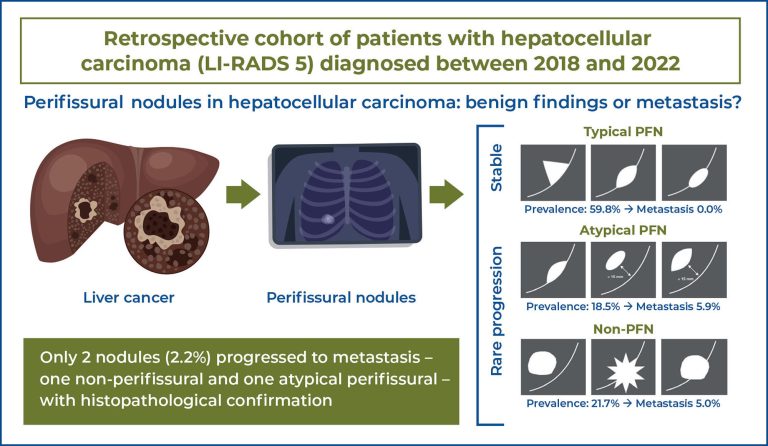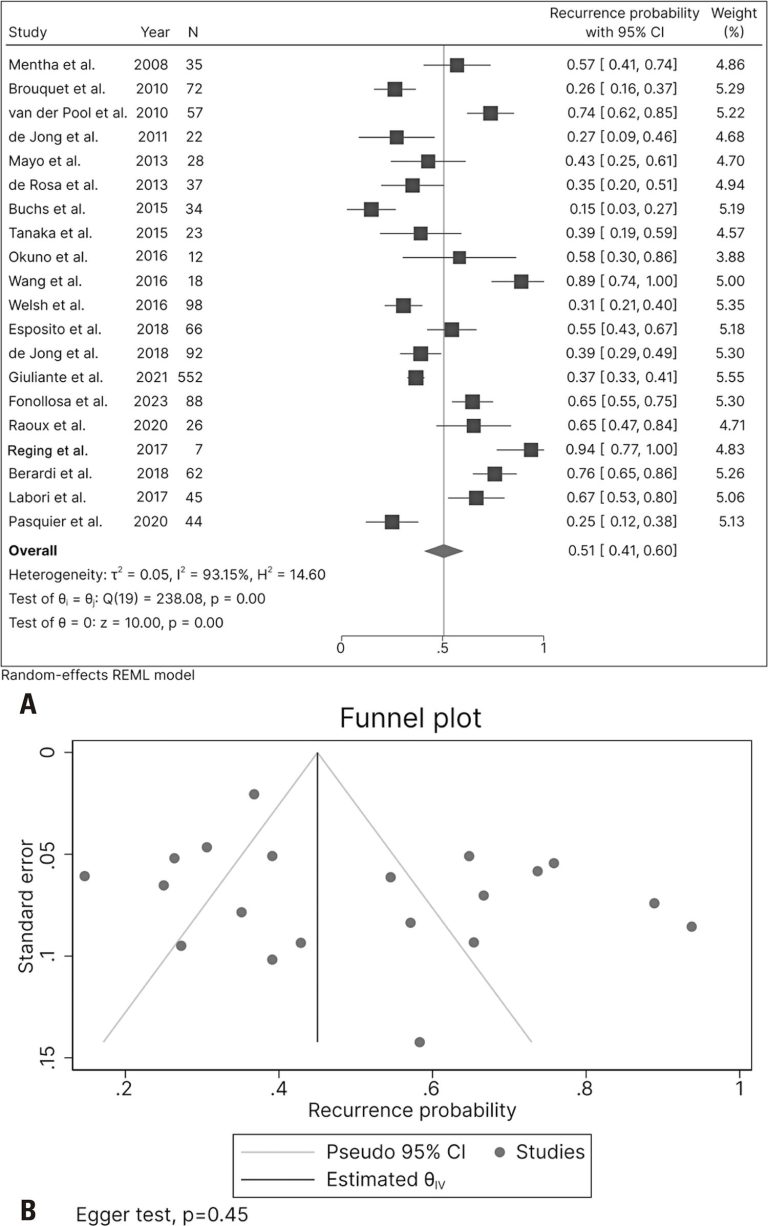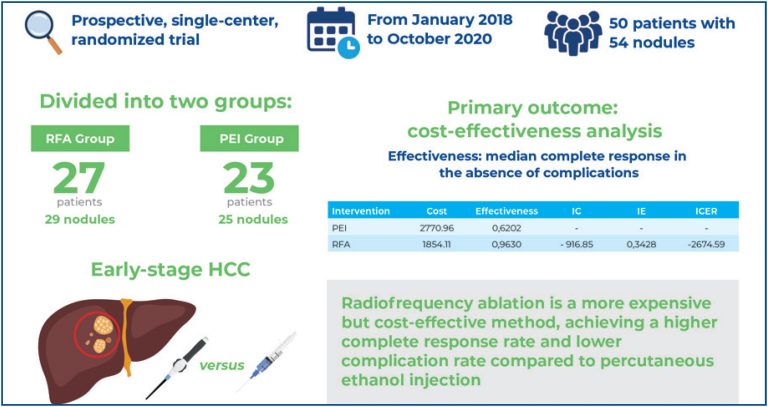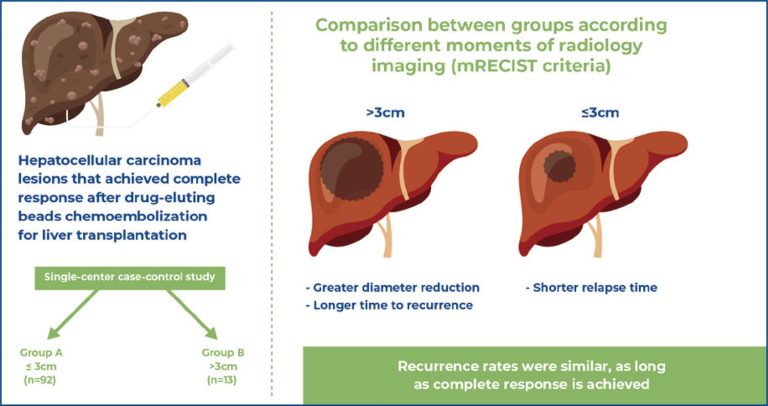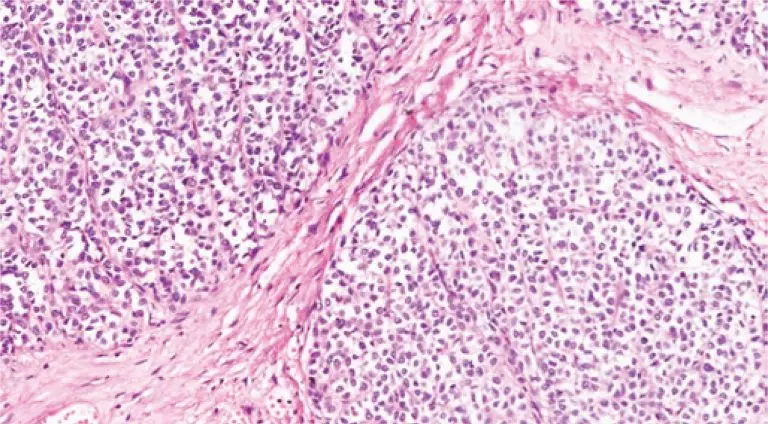25/nov/2025
Pulmonary nodules near fissures in hepatocellular carcinoma: assessing their clinical significance
DOI: 10.31744/einstein_journal/2025AO1895
Highlights ■ Typical perifissural nodules remain radiologically stable with no metastatic potential. ■ Only two nodules progressed to metastasis (one atypical perifissural nodule and one non-perifissural nodule). ■ Atypical and non-perifissural nodules require closer follow-up. ■ Annual growth rate was a strong marker of malignancy. ABSTRACT Objective: To evaluate whether pulmonary nodules adjacent to fissures, particularly perifissural nodules detected on chest computed tomography in patients with hepatocellular carcinoma, can be reliably classified as benign based on their radiological characteristics. Methods: […]
Palavras-chave: Carcinoma hepatocelular; Diagnóstico por imagem; Neoplasias do fígado; Multiple pulmonary nodules; Metástase neoplásica
Comparing radiological response to radiofrequency ablation, percutaneous ethanol injection, and transarterial chemoembolization in patients with hepatocellular carcinoma on the waiting list for liver transplant
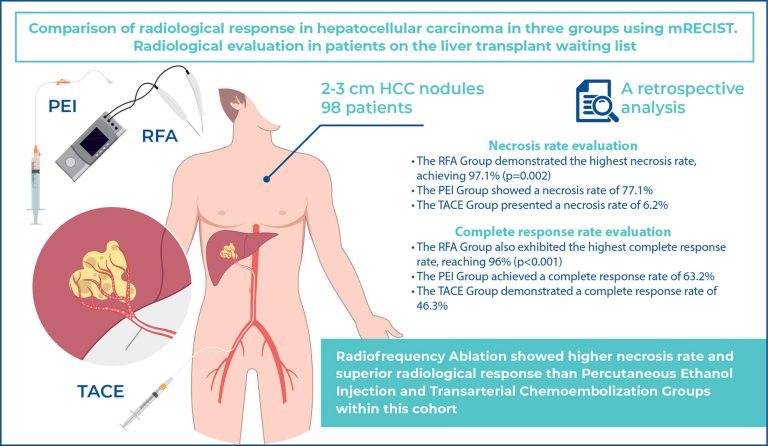
10/nov/2025
Comparing radiological response to radiofrequency ablation, percutaneous ethanol injection, and transarterial chemoembolization in patients with hepatocellular carcinoma on the waiting list for liver transplant
einstein (São Paulo). 10/nov/2025;23:eAO1315.
Ver Artigo10/nov/2025
Comparing radiological response to radiofrequency ablation, percutaneous ethanol injection, and transarterial chemoembolization in patients with hepatocellular carcinoma on the waiting list for liver transplant
DOI: 10.31744/einstein_journal/2025AO1315
Highlights ■ Minimally invasive neoadjuvants are usually recommended for patients on the transplant waiting list. ■ Radiofrequency ablation showed a higher necrosis rate and superior radiological response than did percutaneous ethanol injection and transarterial chemoembolization in this study cohort. ABSTRACT Objective: We aimed to compare the radiological response in small hepatocellular carcinomas treated with radiofrequency ablation, percutaneous ethanol injection, and transarterial chemoembolization using the modified Response Evaluation Criteria in Solid Tumor radiological evaluation in patients on the waiting list for […]
Palavras-chave: Catheter ablation; Chemoembolization therapy; Etanol; Hepatocellular carcinoma; Neoplasias do fígado; Transplante de fígado; Radiofrequency ablation; Listas de espera
13/nov/2024
Liver-first approach to the treatment of patients with synchronous colorectal liver metastases: a systematic review and meta-analysis
DOI: 10.31744/einstein_journal/2024RW0596
ABSTRACT Objective The optimal approach to the treatment of colorectal carcinoma and synchronous liver metastases remains controversial. The objective of this review was to analyze the outcomes of adopting the liver-first approach for the treatment of patients with colorectal cancer with synchronous hepatic metastases who initially underwent systemic chemotherapy and/or resection of the metastatic lesions and primary colorectal carcinoma. Methods This review was conducted in accordance with the Preferred Reporting Items for Systematic Reviews and Meta-Analyses guidelines. The MEDLINE, EMBASE, […]
Palavras-chave: Neoplasias colorretais; Hepatectomia; Neoplasias do fígado; Liver surgery; Metástase neoplásica
25/set/2024
Cost-effectiveness of radiofrequency ablation versus percutaneous ethanol injection for early hepatocellular carcinoma in a resource-poor setting: a randomized trial
einstein (São Paulo). 25/set/2024;22:eGS0683.
Ver Artigo25/set/2024
Cost-effectiveness of radiofrequency ablation versus percutaneous ethanol injection for early hepatocellular carcinoma in a resource-poor setting: a randomized trial
DOI: 10.31744/einstein_journal/2024GS0683
Highlights Radiofrequency ablation and percutaneous ethanol injection are neoadjuvant hepatocellular carcinoma treatment methods. Radiofrequency ablation achieves a higher complete response rate (96.3% versus 60.0%, p=0.001). Total cost analyses showed radiofrequency ablation as a more expensive method (p<0.001). The incremental cost-effectiveness ratio was US$ -2674.59 with an advantage for radiofrequency ablation. Incremental effectiveness (34.2%) was in favor of radiofrequency ablation versus percutaneous ethanol injection. ABSTRACT Objective: This study assessed the cost-effectiveness of radiofrequency ablation compared with percutaneous ethanol injection in patients […]
Palavras-chave: Ablation techniques; Avaliação de custo-efetividade; Neoplasias do fígado; Transplante de fígado; Radiology, Interventional
19/out/2023
Radiological characteristics of hepatocellular carcinoma that achieved complete response after chemoembolization with drug-eluting beads for liver transplantation planning
einstein (São Paulo). 19/out/2023;21:eAO0307.
Ver Artigo19/out/2023
Radiological characteristics of hepatocellular carcinoma that achieved complete response after chemoembolization with drug-eluting beads for liver transplantation planning
DOI: 10.31744/einstein_journal/2023AO0307
Highlights Once complete hepatocellular carcinoma necrosis is achieved, the diameter of the hepatocellular carcinoma decreases significantly, regardless of its initial size. Hepatocellular carcinoma >3cm showed greater reduction and longer time to recurrence. Hepatocellular carcinoma ≤3cm exhibited a shorter time to relapse. Recurrence rates were similar, as long as complete response was achieved. ABSTRACT Objective: To describe the radiological characteristics of hepatocellular carcinoma (HCC) lesions that achieved a complete response following drug-eluting bead transarterial chemoembolization (DEB-TACE) preceding liver transplantation. Methods: This […]
Palavras-chave: Carcinoma hepatocelular; Quimioembolização terapêutica; Neoplasias do fígado; Living donors; Terapia neoadjuvante; Radiology, Interventional; Response evaluation criteria in solid tumors
18/nov/2014
Tumor neuroendócrino primário do fígado: descrição de caso e revisão da literatura
DOI: 10.1590/S1679-45082014RC2745
Tumores carcinoides primários do fígado são neoplasias derivadas de células neuroendócrinas produtoras de hormônios, extremamente raras e de difícil diagnóstico antes da biópsia, ressecção cirúrgica ou mesmo da necrópsia. Em recente publicação, descreveram-se apenas 94 casos dessa afecção. É uma doença sem predileção por sexo e que, aparentemente, não tem associação com cirrose, nem com doença hepática preexistente. O tratamento que se demonstra mais eficaz é a hepatectomia, cuja extensão da ressecção é determinada pelo tamanho e pela localização das […]
Palavras-chave: Neoplasias do fígado; Relatos de casos; Tumor carcinoide; Tumores neuroendócrinos/diagnóstico


